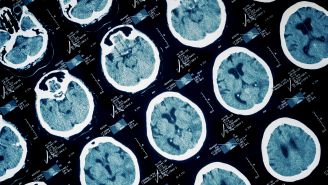Updated on February 17, 2023.
Most people have heard of Alzheimer’s disease, but fewer are familiar with frontotemporal dementia (FTD), also known as frontotemporal lobar degeneration. Although FTD is rare, this group of brain disorders is the most common cause of dementia in people under the age of 60. In fact, about 60 percent of people with FTD are between the ages of 45 and 64 years old. Overall, it’s estimated that the condition affects roughly 50,000 to 60,000 Americans.
With FTD, the nerve cells in the brain’s frontal lobes (the area behind the forehead) and temporal lobes (the area behind the ears) deteriorate and shrink, which dramatically affects a person’s ability to function mentally and physically.
It is not always possible to predict how long someone with FTD will live. Average life expectancy ranges from 7 to 13 years after the onset of symptoms, but some people may die within two years after they are diagnosed. Although some treatments may ease the symptoms of FTD, there is no cure.
Here are four must-know facts about FTD.
The condition can manifest in different ways
The most common symptoms of FTD involve changes in one’s personality and behavior, with less of an impact on memory. This type of FTD is known as behavioral variant frontotemporal dementia (bvFTD). Symptoms may include the following:
- Socially inappropriate behavior
- A focus on repetitive or compulsive routines
- Lack of empathy and deterioration in social skills
- Apathy, or lack of interest in activities
- Problems with reasoning and judgment
- Impulsive (even illegal) behavior, such as stealing or physical assault
- Changes in eating habits
Some types of FTD involve problems with language or speech impairment. Symptoms of this type, known as primary progressive aphasia (PPA), include:
- Difficulty understanding written and spoken language
- Having trouble assigning names to objects
- Problems constructing sentences
- Speech that sounds hesitant or slurred
- Inability to speak
Rarer types of FTD may involve movement issues, with symptoms such as:
- Clumsiness and frequent falls
- Stiffness and slowness
- Muscle weakness and spasm
- Difficulty swallowing
Because many of these symptoms overlap with other conditions, and because people with FTD are often younger than expected for someone with dementia, FTD is commonly misdiagnosed as Parkinson’s disease, bipolar disorder, schizophrenia, or even addiction.
The cause is often unknown
People with FTD make up 10 to 20 percent of dementia cases. It sometimes runs in families, so if you have a relative with FTD, your chances of developing the disease may be higher. That said, more than half of FTD patients appear to have no family history of dementia.
Researchers have discovered several genetic mutations that can lead to FTD. An estimated 10 to 30 percent of cases of bvFTD, for example, are believed to have specific genetic links. In most cases, however, the cause of FTD is not known.
There’s no way to stop It
Unfortunately, no medicine, supplement, or behavioral intervention can slow the progress of this incurable disease. A few treatments, however, can help with certain symptoms—for a certain amount of time.
Certain medications may help ease some behavioral symptoms of FTD. Antidepressants can help treat impulsive behavior, and low doses of antipsychotic medications may be used for aggression or delusions.
Physical and occupational therapy may help with movement issues, and working with a speech-language pathologist may be able to help with language and communication.
Research is underway
While there’s still much to be learned about FTD, researchers are working to better understand the biological changes and genetic underpinnings that may contribute to the disease. This work may lead to the development of new drugs to treat FTD and a better understanding of how to target those drugs to specific patients.
If you or someone you love has received a diagnosis of FTD, know that there is help available. The Association for Frontotemporal Degeneration also offers facts about the disease, ways to find support, and information how to get involved in clinical research into causes and potential cures. You can also search clinical trials through the National Institutes of Health to see if one may fit your profile.







